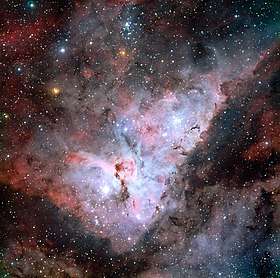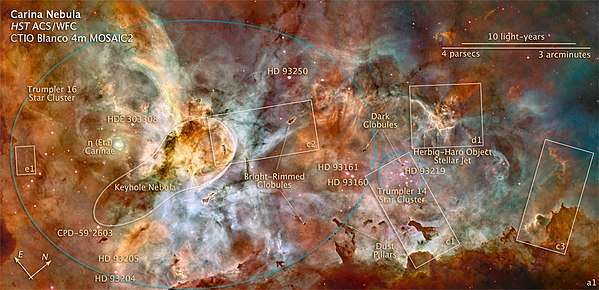HD 93250
HD 93250 is a highly luminous hot blue binary star in the Carina Nebula in the constellation Carina.
 HD 93250 is the bright star just above and left of the centre of this image of the Carina Nebula, directly above the Keyhole Nebula. Credit: ESO | |
| Observation data Epoch J2000 Equinox J2000 | |
|---|---|
| Constellation | Carina |
| Right ascension | 10h 44m 45.026s[1] |
| Declination | −59° 33′ 54.68″[1] |
| Apparent magnitude (V) | 7.41[2] |
| Characteristics | |
| Spectral type | O4 IV(fc)[3] |
| U−B color index | −0.85[2] |
| B−V color index | +0.17[2] |
| Astrometry | |
| Radial velocity (Rv) | 11.6[4] km/s |
| Proper motion (μ) | RA: −7.27[1] mas/yr Dec.: +2.45[1] mas/yr |
| Parallax (π) | 0.53 ± 0.42[1] mas |
| Distance | 2,350[5] pc |
| Absolute magnitude (MV) | −6.14[6] |
| Details[6] | |
| Mass | 83.3 (65[7]) M☉ |
| Radius | 15.9 R☉ |
| Luminosity | 1,000,000 L☉ |
| Surface gravity (log g) | 3.96 cgs |
| Temperature | 46,000 K |
| Rotational velocity (v sin i) | 130 km/s |
| Age | 1.3 Myr |
| Other designations | |
| Database references | |
| SIMBAD | data |
Location

HD 93250 is one of the brightest stars in the region of the Carina Nebula. It is only 7.5 arc-minutes from the famous Eta Carinae[5] and HD 93250 is considered to be a member of the same loose open cluster Trumpler 16, although it appears closer to the more compact Trumpler 14.[8]
HD 93250 is in a region of the Carina Nebula with several bright stars, for example HD 93268 and HDE 303311, but relatively few faint stars. It has been proposed that these bright stars are the core of a separate cluster called Collinder 232, but the lack of any concentration of fainter stars in the area makes it more likely that Collinder 232 is not a real cluster and HD 93250 is just an outlying member of one of the more obvious clusters.[9]
Membership of Trumpler 16 constrains the distance and likely age of HD 93250.[6]
Spectrum
Although HD 93250 is known to be a binary star, individual spectra of the two components have never been observed, although they are thought to be very similar. The spectral type of HD 93250 has variously been given as O5,[10] O6/7,[11] O4,[12] and O3.[13] It has sometimes been classified as a main sequence star and sometimes as a giant star.[12][13] The Galactic O-Star Spectroscopic Survey has used it as the standard star for the newly created O4 subgiant spectral type.[3]
Binary
HD 93250 is the brightest x-ray source in the Carina Nebula.[5] It has long been suspected that this is due to colliding winds in a close pair of hot luminous stars, but investigations have failed to show any significant radial velocity variations to support this.[4]
In 2010, AMBER interferometry resolved HD 93250 into two separate stars. No relative motion or radial velocity variations could be detected and so the orbit and properties of the two stars is still uncertain. The projected separation of the stars is 1.5 mas, approximately 3.5 astronomical units. The two stars show no measurable colour difference and are both likely to be hot O stars with masses within 10% of each other.[5]
Properties
The physical properties of HD 93250 have only been calculated on the assumption that it is a single star. The temperature is around 50,000 K and its luminosity around 1,000,000 L☉ Calculations of the mass have shown discrepancies between spectroscopic models and evolutionary models, which may be resolved by analysis of two separate stars in the system.[7]
References
- van Leeuwen, F. (2007). "Validation of the New Hipparcos Reduction". Astronomy and Astrophysics. 474 (2): 653–64. arXiv:0708.1752. Bibcode:2007A&A...474..653V. doi:10.1051/0004-6361:20078357.
- Antokhin, I. I.; Rauw, G.; Vreux, J.-M.; Van Der Hucht, K. A.; Brown, J. C. (2008). "XMM-Newton X-ray study of early type stars in the Carina OB1 association". Astronomy and Astrophysics. 477 (2): 593. arXiv:0711.3612. Bibcode:2008A&A...477..593A. doi:10.1051/0004-6361:20065711.
- Maíz Apellániz, J.; Sota, A.; Arias, J. I.; Barbá, R. H.; Walborn, N. R.; Simón-Díaz, S.; Negueruela, I.; Marco, A.; Leão, J. R. S.; Herrero, A.; Gamen, R. C.; Alfaro, E. J. (2016). "The Galactic O-Star Spectroscopic Survey (GOSSS). III. 142 Additional O-type Systems". The Astrophysical Journal Supplement Series. 224 (1): 4. arXiv:1602.01336. Bibcode:2016ApJS..224....4M. doi:10.3847/0067-0049/224/1/4.
- Rauw, G.; Nazé, Y.; Fernández Lajús, E.; Lanotte, A. A.; Solivella, G. R.; Sana, H.; Gosset, E. (2009). "Optical spectroscopy of X-Mega targets in the Carina nebula - VII. On the multiplicity of Tr16-112, HD93343 and HD93250". Monthly Notices of the Royal Astronomical Society. 398 (3): 1582. arXiv:0906.2681. Bibcode:2009MNRAS.398.1582R. doi:10.1111/j.1365-2966.2009.15226.x.
- Sana, H.; Le Bouquin, J.-B.; De Becker, M.; Berger, J.-P.; De Koter, A.; Mérand, A. (2011). "The Non-thermal Radio Emitter HD 93250 Resolved by Long Baseline Interferometry". The Astrophysical Journal Letters. 740 (2): L43. arXiv:1110.0831. Bibcode:2011ApJ...740L..43S. doi:10.1088/2041-8205/740/2/L43.
- Repolust, T.; Puls, J.; Herrero, A. (2004). "Stellar and wind parameters of Galactic O-stars. The influence of line-blocking/blanketing". Astronomy and Astrophysics. 415: 349. Bibcode:2004A&A...415..349R. doi:10.1051/0004-6361:20034594.
- Weidner, C.; Vink, J. S. (2010). "The masses, and the mass discrepancy of O-type stars". Astronomy and Astrophysics. 524: A98. arXiv:1010.2204. Bibcode:2010A&A...524A..98W. doi:10.1051/0004-6361/201014491.
- Smith, Nathan (2006). "A census of the Carina Nebula - I. Cumulative energy input from massive stars". Monthly Notices of the Royal Astronomical Society. 367 (2): 763–772. arXiv:astro-ph/0601060. Bibcode:2006MNRAS.367..763S. doi:10.1111/j.1365-2966.2006.10007.x.
- Tapia, Mauricio; Roth, Miguel; Vázquez, Rubén A.; Feinstein, Alejandro (2003). "Imaging study of NGC 3372, the Carina nebula - I. UBVRIJHK photometry of Tr 14, Tr 15, Tr 16 and Car I". Monthly Notices of the Royal Astronomical Society. 339 (1): 44–62. Bibcode:2003MNRAS.339...44T. doi:10.1046/j.1365-8711.2003.06186.x.
- Thackeray, A. D.; Tritton, S. B.; Walker, E. N. (1973). "Radial velocities of southern B stars determined at the Radcliffe Observatory—VII". Memoirs of the Royal Astronomical Society. 77: 199. Bibcode:1973MmRAS..77..199T.
- Houk, N.; Cowley, A. P. (1975). "University of Michigan Catalogue of two-dimensional spectral types for the HD stars. Volume I. Declinations -90_ to -53_ƒ0". University of Michigan Catalogue of Two-dimensional Spectral Types for the HD Stars. Volume I. Declinations -90_ to -53_ƒ0. Bibcode:1975mcts.book.....H.
- Walborn, Nolan R.; Sota, Alfredo; Maíz Apellániz, Jesús; Alfaro, Emilio J.; Morrell, Nidia I.; Barbá, Rodolfo H.; Arias, Julia I.; Gamen, Roberto C. (2010). "Early Results from the Galactic O-Star Spectroscopic Survey: C III Emission Lines in of Spectra". The Astrophysical Journal Letters. 711 (2): L143. arXiv:1002.3293. Bibcode:2010ApJ...711L.143W. doi:10.1088/2041-8205/711/2/L143.
- Williams, S. J.; Gies, D. R.; Hillwig, T. C.; McSwain, M. V.; Huang, W. (2011). "Radial Velocities of Galactic O-type Stars. I. Short-term Constant Velocity Stars". The Astronomical Journal. 142 (5): 146. Bibcode:2011AJ....142..146W. doi:10.1088/0004-6256/142/5/146.